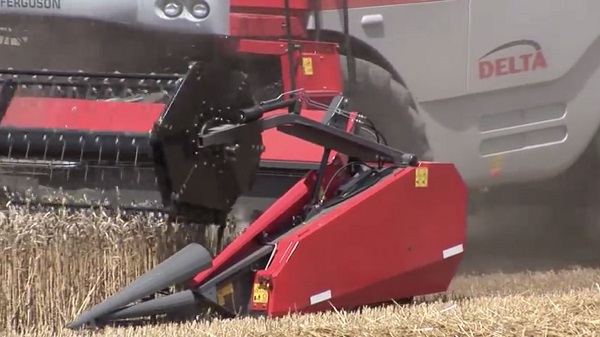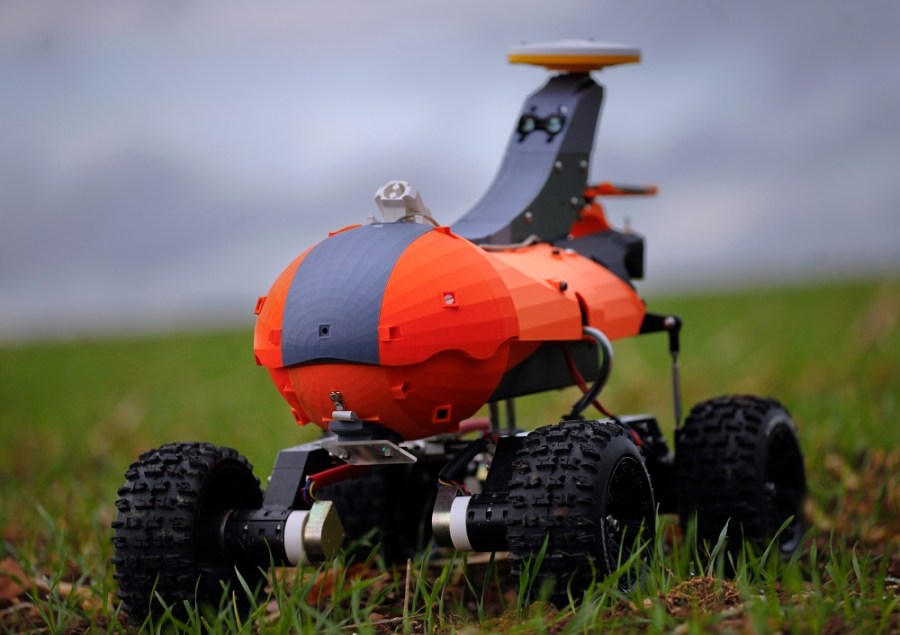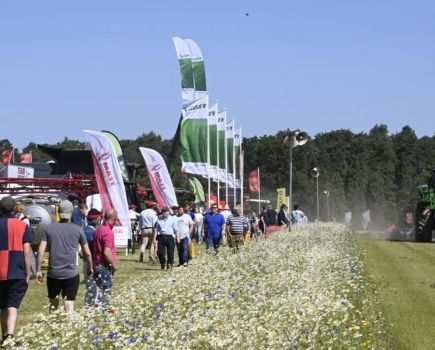As 2020 begins, CPM has taken a look back on some of the most interesting launches over the past 10 years to highlight a decade of innovation.
We believe there’s now no technological barrier to automated field agriculture.
By Charlotte Cunningham
The passing of another year and the start of a brand new decade marks an apt time to reflect on what has come and gone.
Over the past 10 years, the ag tech industry has seen a wide array of innovative kit launches with everything from brand new gearbox technology to the world’s first autonomous tractor.
To kick off the new year in style, CPM has taken a look at some of the most notable launches over the past 10 years.
2010
Cereals 2010 saw Massey Ferguson unveil its MF 9280 Delta combine, which was the firm’s first machine to optimise ‘hybrid’ technology. This meant using a conventional threshing system, followed by completely new twin rotor separation.

Cereals 2010 saw Massey Ferguson unveil its MF 9280 Delta combine
Speaking at the time, a spokesman for the firm said: “We’re confident this combine will put us in the capacity stakes where it matters for large scale producers. Tests show the combine not only provides the performance, but uses 10% less fuel for the same output in equivalent conditions.”
The 9280 Delta was powered by a seven-cylinder 9.8-litre engine and was claimed to be the world’s first combine to use Selective Catalytic Reduction, in a bid to control emissions.
2011
Back in 2011, Amazone made the headlines with the launch of the Pantera 4001 — the firm’s first self-propelled sprayer to be designed and built entirely in-house –– with both the spray pack and chassis now produced by the company.
With a debut at LAMMA that year, the Pantera 4001 came available in boom widths up to 40m and a 4000-litre tank capacity.
Though automation still feels relatively new, Amazone were early adopters and the Pantera boasted plenty of precision features such as GPS-Switch and GPS-Track, with the sprayer controlled through the firm’s Amadrive touch-screen terminal.
2012
As a result of the new emission limits brought in the year before, 2012 saw a flurry of new tractors introduced. Among these was New Holland’s new T6 range which debuted seven new models at LAMMA, ranging between 119hp-175hp— all powered by SCR-equipped engines from the firm’s in-house Fiat Powertrain Technologies.
New Holland’s confidence in its engines was so much so that they also presented figures of fuel savings as a result of employing SCR.
As reported in CPM at the time, tests showed the T7.250 model could save £3,517 per 1000h in fuel costs (including its AdBlue consumption) compared with the previous Stage 3a engine-powered T7050 –– both 180hp.
2013
John Deere turned heads in 2013 with new gearbox technology that up until then, was claimed to only be optimised by race cars.
After five years in development, the DirectDrive was launched as a rival to the infinitely variable transmission gearbox, using technology to automatically change through eight gears, set in three ranges.
The gearbox comprised two main drive shafts, each having four-speed gearing and an individual clutch and working in parallel of each other — one engaging at the same time as the other disengages in order to move through the gears.
John Deere said that this meant operations could continue without any disruption to the power flow.
Speaking at the time, a spokesman said: “You can either drive fully automatically, just as you would with an IVT transmission, or select one of the three ranges to suit the task in hand. The ranges are tailored to use, and they’re designed so there’s no chance you’d need to change range in the field.”
2014
Heading towards the midpoint of the decade, 2014 saw strip-till specialists, Claydon move away from their traditional mounted ranges and introduced a brand new trailed series — the Hybrid T — firstly as a 6m drill, but with an 8m version in the pipeline.
Speaking at the time in CPM, Spencer Claydon said: “As with our other machines, we’ve trialed this design extensively on our own farm and elsewhere before putting it into production. But while the design has changed for the trailed format, the concept remains the same. The Hybrid T uses the twin-tine direct strip-till seeding system for which we hold a patent, with leading breaker tines followed by the A shares down the back of which the seed is fed.
“There are two banks of individually adjustable tungsten-carbide tines spaced 2.5m apart, giving a minimum inter-tine clearance of 550mm, while row spacing can be set at either 300mm or 600mm. Hydraulic reset breakback protection is standard.”
2015
2015 was a busy year for Amazone with a huge array of new launches warranting a feature of its own in the March issue of CPM that year.
Among them, was the ZA-V spreader, which featured a new spreading system developed entirely with the aid of three-dimensional spread patterns.
Amazone claimed at the time that this would bring up to 20% more throwing width, compared with other twin-disc spreaders in the ZA-V’s class, producing more consistent and more precise spread patterns, even at wide working widths.
2016
Spawning from an idea by researchers at Harper Adams, 2016 saw the university announce its ambition to grow and harvest a hectare of cereals, all without stepping foot into the field.
The project was aptly given the now well-known title of “Hands Free Hectare” and since its launch has successfully sown and harvested a number of different crops.
Speaking back in November 2016, Kit Franklin said: “As a team, we believe there is now no technological barrier to automated field agriculture. This project gives us the opportunity to prove this and change the current public perception.
“Previously, people have automised sections of agricultural systems, but funding and interest generally only goes towards one single area. We’re hoping to string everything together to create one whole system, which will allow us to farm our hectare of cereal crop from establishment to harvest, without having to go into the field.”
“We’re confident that we’re going to be successful implementing current open source technology, but obviously there is an element of risk. This is the first time in the world that this has been done but pushing boundaries is what engineering research is about.”
And pushing the boundaries is certainly what they’ve done over the past decade…
2017
Fendt stole the show in 2017 with the launch of its Ideal combine.
The firm called it the first “clean-sheet” design of an axial combine in the industry in 30 years, and claimed to set a new standard for harvesting automation with the latest addition to its fleet.
After seven years of testing, the Ideal was unveiled to the public at Agritechnica 2017. Speaking at the time, Fendt’s Caleb Schelder said: “The Fendt Ideal is a game changer because it is highly automated, but easy to operate. We created this combine to bring our customers peace of mind that they can go to the field, run steadily all day long and get the crop harvested with great efficiency and minimal downtime.”
2018
In 2018, the Small Robot Company introduced the concept of Tom, Dick and Harry to the world — a small fleet of robots aimed at achieving a more sustainable form of food production, reducing environmental impact of farming and increasing farm outputs globally through the use of automation and artificial intelligence.
Since then, the company and the robots have come on leaps and bounds and helped push the industry further into the fourth agricultural revolution.
And it’s not just the ag sector that’s been impressed. In a bid to accelerate the development of the tech, the firm launched a number of crowdfunding campaigns which all together have raised over £1.9m — highlighting just how much support there is from this next generation of technology.
2019
The end of the decade brought some truly wonderful technology, building to a crescendo of innovation at last year’s Agritechnica.
Perhaps one of the most jaw-dropping developments of the year was the VoloDrone — a major breakthrough in drone technology that comes as the result of a collaboration between John Deere and Volocopter.
Featuring a potential payload of 200kg, the VoloDrone is able to cover an enormous area, especially under difficult operating conditions.
The VoloDrone is powered by 18 rotors with an overall diameter of 9.2m, and features a fully electric drive using replaceable lithium-ion batteries. One battery charge allows a flight time of up to 30 minutes, and the VoloDrone can be operated remotely or automatically on a pre-programmed route.
With large drones becoming an increasingly important part of modern day farming, it’ll be interesting to see where the next 10 years of innovation lead to.




